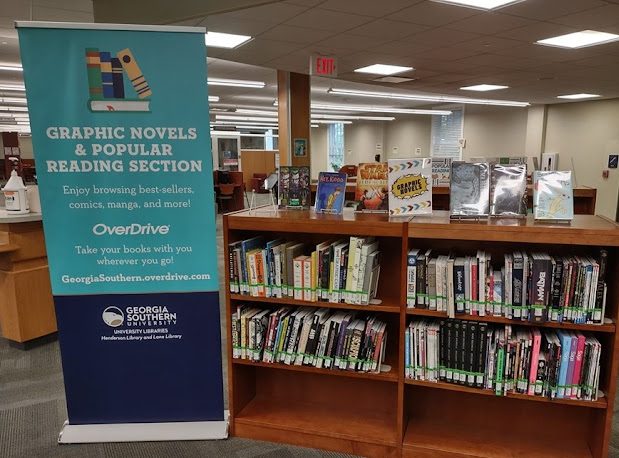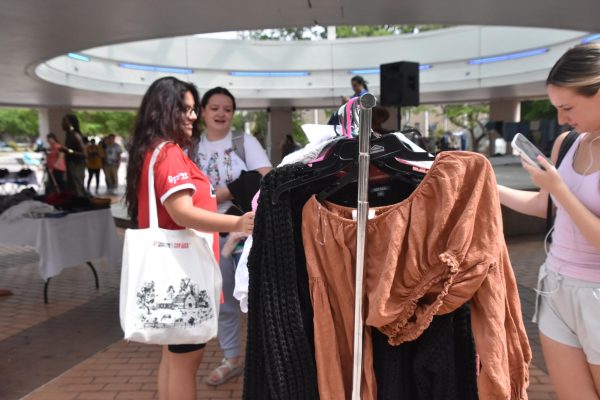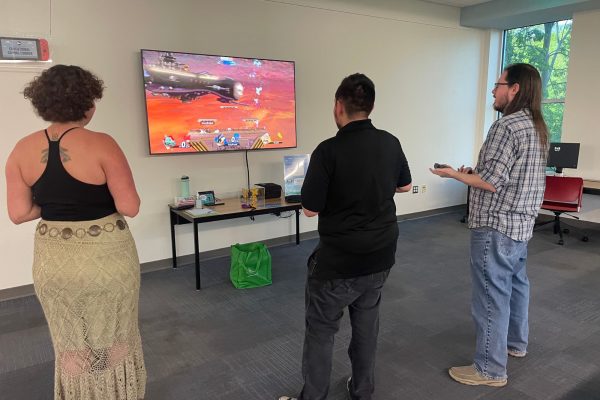GS Dining Services: the good, the bad and the hungry
October 17, 2016
Eagle Dining Services (EDS), one of the most well known entities on Georgia Southern’s campus, is taken advantage of by almost every student or faculty and staff member each year.
Whether it is grabbing their favorite drink at Starbucks, a sandwich at one of the many sandwich places located on campus or just picking up something from Gus Mart, individuals at GS might often believe that there is nothing more to EDS than dining halls or coffee. However, there is more to Eagle Dining than meets the eye.
The past, present and future of EDS
The changes in Eagle Dining Services have created a more diverse and convenient service for the GS community. In the past few years, students have seen Dining Services transform itself.
From renovations and grand openings of two major dining facilities, Dining Commons and Lakeside Dining Commons, to the coming and going of a variety of restaurants and the expansion of eagle dining plans, GS’ Eagle Dining Services has had big changes with hopes of even bigger changes to come.
As for the future of EDS, executives are always looking into expanding, whether it be new restaurant or a different dining plan.
In order to bring another element into Eagle Dining, many steps have to be taken.
Director of Retail Brands and Catering, Mark Braswell, explains that although there are plenty of ideas, it cannot happen over night.
“We are always looking. We have reached out to several restaurants and many [ideas] have been thrown onto my desk.” Braswell said. “We have to do the research.”
Considerations for new restaurants would have to be determined on major elements, including space, building infrastructure and student participation.
In the past, restaurants like Chipotle, Dunkin Donuts and Five Guys have been looked at as having potential to be a new food service on campus, but were deemed unfit because of constraints on both the Eagle Dining side and the restaurant’s side.
All in all, the state of Eagle Dining Services is sure to expand and reach towards higher lengths to create the best dining service for the GS community in the months and years to come.
Tapingo lines frustrate students
Tapingo is an ordering service that many Georgia Southern students know and love, or at least try to.
The Tapingo mobile app service has become increasingly popular since its release to the GS campus in fall 2014. Based out of San Francisco, Tapingo was designed for college campuses to cut down the wait and delivery time at various on and off campus eateries.
Wait more, live less
GS’ own wait times have been lackluster, at best, according to many students. Recently, Tapingo services have created complications for GS customers, as lines for restaurants have grown longer and the app has been down during various moments, including the lunch period, leaving customers questioning the service itself.
Alana Bray, sophomore early childhood education major, wishes that the service would be more efficient for people on the go.
“[I’ve waited] maybe 15 to 20 minutes tops because of the line ahead of me, but it was during lunch time at Chick-fil-A, so that’s understandable,” Bray said.
Bray typically orders Tapingo around lunch time, which is known to be one of the most busiest times for the service, as many students are trying to get lunch or drinks before their next class or during a break in between classes.
“It’s fast, but it could be improved because sometimes there is still a big line for it,” Bray said.
GS was one of the first universities to utilize Tapingo, according to Braswell.
“We [Eagle Dining] oversee every element of these operations,” Braswell said, “If there is a service constraint, that is our responsibility.”
Destiney Watson, senior communication arts major, believes that Tapingo services have been beneficial to campus, but would also like to see some improvements.
“I do think the theory [Tapingo] is great, but certain places are counterproductive sometimes,” Watson said. “They should have one to two people devoted to Tapingo.”
Mo’ students, mo’ problems
Each semester comes with unique problems that Dining Services has to work with.
“There have been a few times that it’s [Tapingo] been offline that we’ve intentionally taken it offline because we couldn’t meet the needs of the customers,” Braswell said.
Fall semester typically sees an influx of new freshman eager to use their dining dollars and Eaglexpress cash. As a result, lines and wait times are usually longer than in the spring.
Dining places also see a shortage of staff in the Fall due to Spring graduates and school schedule changes.
“Sometimes it’s challenging to get enough employees to meet the needs of our campus in a timely fashion,” Jeffery Yawn, executive director of Eagle Dining Services, said.
Good to go
Despite these problems, Braswell believes Tapingo has improved Eagle Dining in a positive way, especially when the change of dining plans decreased retail revenue.
“Adding Tapingo back actually increased the retail sales. While we don’t have a specific percentage, it was significant enough to notice,” Braswell said.
Jenna Lawson, director of Auxiliary Marketing, attributes Tapingo’s success to Eagle Dining’s customer service.
“[Eagle Dining] wanted to provide a service to the students that was going to be convenient to them and fit their lifestyle,” Lawson said.
For the future of Tapingo, Eagle Dining is looking into hiring staff members strictly to handle Tapingo orders and decrease the flow of traffic and time spent waiting for orders.
“If a change in our operations creates a change in the service we’re offering, we’re going to adapt appropriately,” Yawn said.
Budget Bucks vs. Eaglexpress
For most students at Georgia Southern, a dining plan has become an essential for on-campus living. Each plan provides a variety of options that can be customized to fit the student’s and/or faculty and staff’s needs.
Two of those dining plans, Budget Bucks and Eaglexpress, provide a similar outcome: the payment for dining services, but also provide differences as well, including in deposits and well as where their payment will be accepted.
A closer look
The cash: Budget Bucks can only be spent with Eagle Dining facilities and restaurants and used on campus. Eaglexpress can be used to pay for not just dining services, but for printing points, parking ticket payments, purchases at the Tech Store and more. Eaglexpress can also be used outside of campus at specific vendors, such as Bi-Lo, CVS and Dairy Queen.
The deposits: Budget Bucks requires the payment for the 480 or 960 plan upfront at the beginning of each semester. Budget Bucks money is deposited every Monday. If Budget Bucks isn’t fully used in a week, the remaining amount will rollover into the next week and into the next semester if needed.
For Eaglexpress, a set amount is deposited at the beginning of each semester as well. However, once the balance starts declining, funds will have to be reloaded by either the student or a family member.
The eating plans: Budget Bucks has two plans, each varying depending on how much one is willing to spend a week for food. It costs $8.75 per entry to either of the two dining halls on campus. When not used at a dining hall, Budget Bucks works just like dining dollars.
Eaglexpress does not have a meal plan or requirement payment. It costs $8.75 each meal at the Dining Commons or Lakeside, as opposed to increasing dollar amounts at lunch or dinner time.
The cash back: Although Eaglexpress money does not expire each semester, withdrawing cash is not allowed until after graduation. Students who would like to withdraw money will be allowed to send in a written request form after graduation.
Photo courtesy of Xxavier Robertson.







